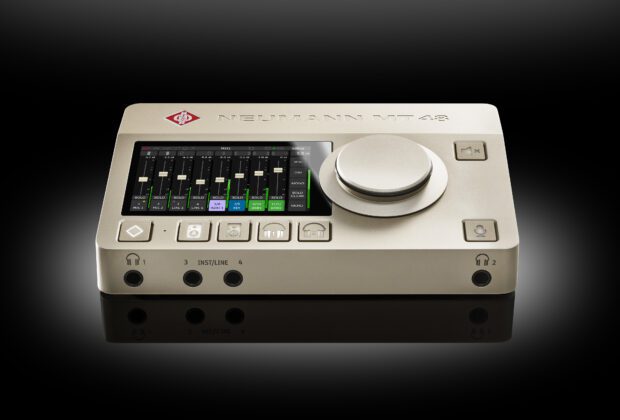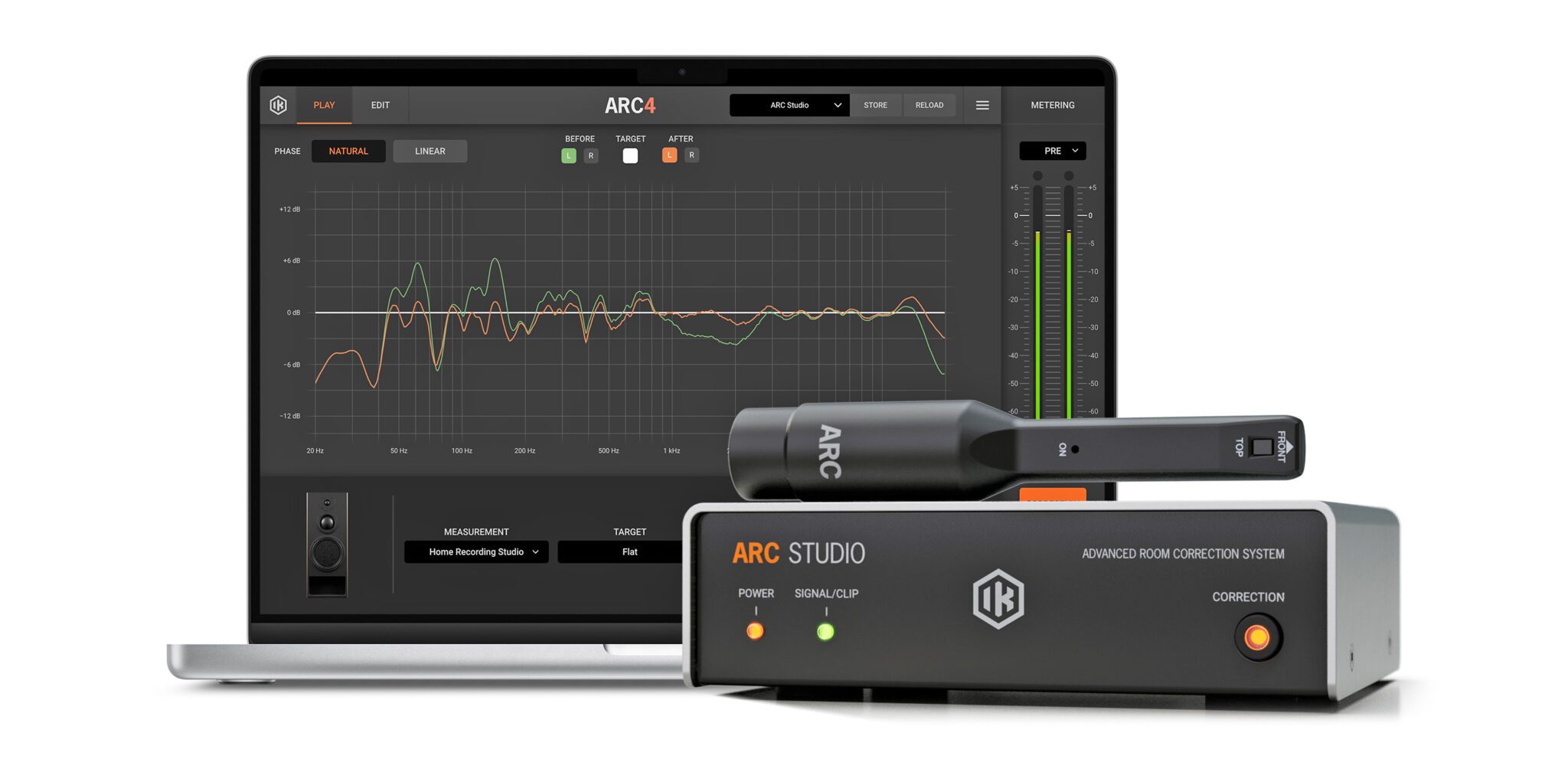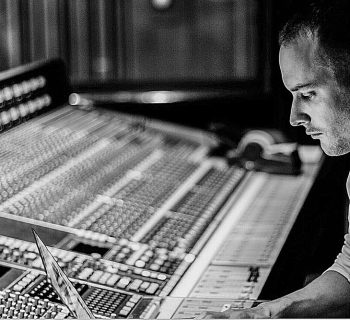Neumann’s MT 48 is a premium quality four-input, eight-output audio interface and is Neumann’s first-ever Audio Interface. MT stands for Merging Technologies, an innovative company from Switzerland that has now become part of The Sennheiser Group. The MT 48 looks and feels extremely solid, the overall build quality is immediately apparent as soon as you pick it up.
The MT 48 has four analog inputs and eight analog output channels. The first two inputs are on the back in the form of Neutrik combo jacks. The XLR part is for microphone signals, the TRS part is for line sources. Strictly speaking, the MT 48 does not auto-switch, but this is how you should use the combo jack to avoid applying Phantom Power on line level input sources. Next to that are two XLR balanced outputs, which are the main outputs that you typically connect to your studio loudspeakers. If you have a second pair of speakers, you can connect them to outputs three and four, as well as you can use the TRS for re-amping or for sending a monitor mix to a headphone amplifier in a vocal booth.
On the far left and right front of the MT 48 are two headphone outputs. The built-in headphone amplifiers on the MT 48 are, as you would expect from Neumann, are high-end and effectively preclude the need for an external headphone amplifier. Also, on the front of the MT 48 are two more balanced quarter-inch line inputs which can be used for line level signal sources such as external preamps or going direct with your guitar or bass.
The mic preamps, the AD and DA converters, the two headphone amps as well as the DSP specifications on the MT 48 and the Merging Technologies Anubis audio interface are identical. Both interfaces support a sampling frequency of up to 384 kilohertz with 32-bit sampling. The Premium version of the Anubis additionally supports DXD with sampling rates of up to 384 kHz as well as DSD bitstream formats. The mic preamps, the A to D and D to A converters, the two headphone amps as well as the DSP specifications on both interfaces are identical. The major difference is that the Merging Technologies Anubis is a pure network interface that communicates with a computer via an ethernet network port using the AES67 Ravenna protocol whereas the MT 48 has USB-C capability. In short, the superior sound quality of the two audio interfaces is identical but the Neumann MT 48 and the Anubis differ in some details, the fundamental difference being that the MT 48 has been optimized for musicians, music production and content creation.
The power supply of the two audio interfaces is also different. Instead of the 12 volts power supply of the Anubis the MT 48 uses a USB-C power supply. This means that the MT 48 can also be used on the go with a USB-C power bank with a power delivery of at least 25 watts. Because the MT 48 is fully class compliant you do not need to use software on the computer to access all the features and audio path. Instead of the second network port found on the Anubis the MT 48 features optical IO for ADAT and SPDIF converters. The MT 48 has two USB Type-C ports. One is for communication with your Mac or PC, and the other is for the power supply.
The MT 48 has available USB drivers for Mac and Windows, and it is also fully class compliant with Apple devices, currently it is not class compliant with Linux or Windows. It is also easy to connect to an iPad for example and allows you to control everything via the MT 48’s touch screen. Now with the latest firmware update, the MT 48 can also communicate with your computer via the Ethernet network port, meaning that if required, significantly higher channel counts can be realized than would otherwise be possible with USB.
The MT 48 has available built-in DSP-based dynamics, EQ, and reverb on all input channels. The Reverb is there for monitor purposes only; EQ and dynamics can be printed. You can even record the raw and the processed signal at the same time using separate driver channels. This is quite unique. Except for the Merging Anubis, I’m not aware of any other audio interface that’s able to do this. Multiple Mixes are possible and comprehensive accessibility of all the features of the MT 48 are available from the full-color touch screen as well as from the available iOS/Windows and web-based remote-control Apps. The MT 48 has one set of ADAT inputs and outputs to add up to eight channels using an external converter. Alternatively, these optical inputs and outputs can also be used in SPDIF mode.
To sum up, everything about the build quality, and overall specs of the MT 48 is first class. With two mc-line inputs, two line/instrument inputs, main outs, secondary outputs, two headphone outputs, and one set of ADAT ports. Yes, the MT48 has all the basic inputs and outputs you would need for a home or project studio.
Other the other hand, the fact that the MT 48 has only one set of ADAT ports means it has a reduced number of inputs at higher sample rates. The MT 48 is overall only capable of streaming up to 32 channels into your DAW via USB. Initially, the MT 48 was limited to stereo, but with the Monitor Mission, announced at NAMM 2024, which transforms the device into a freely configurable monitor controller and audio interface, the MT 48 also supports surround sound and immersive audio formats such as Dolby Atmos 7.1. The MT 48 driver supports up to 32 input and 16 output channels at sampling rates up to 48 kHz. At higher sampling rates up to 96 kHz, the channel count reduces to 16 input and 16 output channels At highest rates up to 192 kHz, the MT 48 driver can handle up to eight input and 16 output channels. This is over USB. AES67 network supports up to 256 I/O channels.
What you’re really paying for with the MT 48 is the quality of the A/D converters and preamps, network capability, full class compliance on Apple devices as well as Mac and PC drivers and tools, and of course, the Neumann name. What the MT 48 does offer beyond the obvious high-end build quality is the ability to control virtually all the MT 48’s features from the onboard touchscreen without the need for an external software app. This allows the MT 48 to excel as a high-end portable audio interface for professional grade location, classical recordings, and voice overs, which is where you will be able to take advantage of the MT 48’s stellar preamps and best-in-class headroom and dynamic range. It’s worth mentioning that the dynamic range is not just a little better than on competing devices which offer 123 dB-A. At 136 dB-A, the MT 48 has more than four times the resolution! Amplitude doubles with every 6 dB.
Given the MT 48’s high-end price point and relatively limited channel count, not to mention the plethora of available interfaces on the market for much less money that offer pretty much the same basic feature set as the MT 48, it is likely not going to be a first choice for most home or project studios. On the other hand, if you are a professional mixing engineer and you have an overall high-end signal path, microphones, and/or at least one pair of Neuman’s network-capable nearfield monitors, then the MT 48 may be right for you.
The Neumann MT 48 is available now for MAP $1,850.













